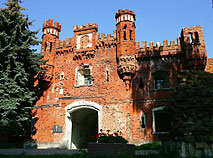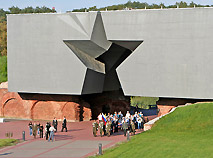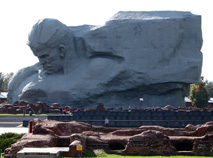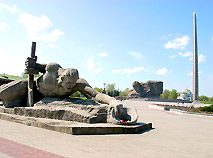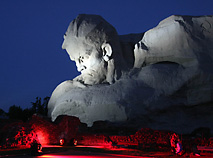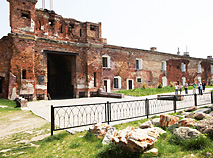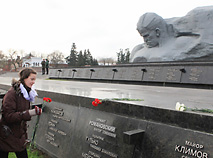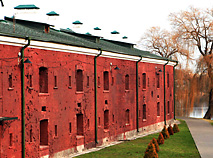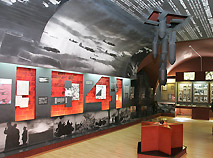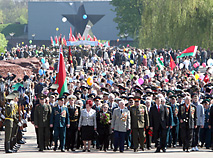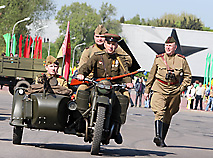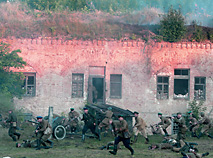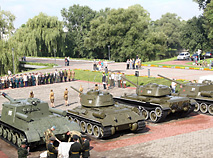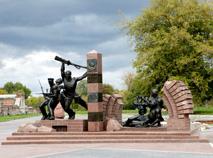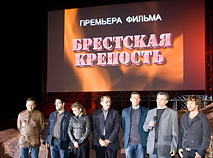Brest Fortress
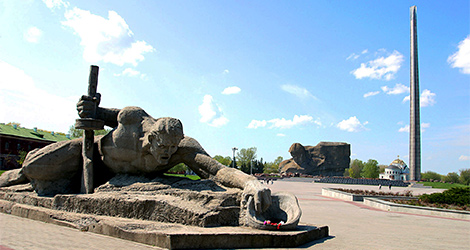
Brest Hero Fortress Memorial
Brest Fortress, one of the most important places in Belarus, dates back to the 19th century and became a key symbol of Soviet resistance in World War 2
See video about Brest Fortress
History of Brest Fortress
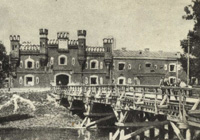 Brest Fortress was built in the 1830s-early 1840s at the meeting-point of the rivers Bug and Mukhavyets.
Brest Fortress was built in the 1830s-early 1840s at the meeting-point of the rivers Bug and Mukhavyets.
During construction, the entire town was relocated to a new position 2km away.
St Nicolas Church was built in 1851-1876. Much of it was severely damaged during World War 2.
The site occupies more than four square km, although many of the outer defences were damaged or destroyed during the wars of the 20th century.
There is a citadel at the centre of the fortress, linked to three artificial island fortifications by bridgeheads:
-
Kobrin fortification (north-eastern side)
-
Terespol fortification (western island)
-
Volyn fortification (south-eastern island)
The fortress was captured by the German army in 1915 and after World War 1 remained within Polish territory. In 1930 it became infamous as a prison in Poland in the aftermath of the Brest Elections.
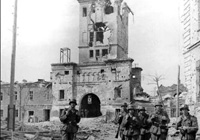 In 1939 Brest Fortress was assigned to the Soviet Union. It earned the title of Hero Fortress for the courage demonstrated by Soviet soldiers when they fought against the German army in 1941. Whilst the Nazis took the town of Brest – 90% of which was destroyed in the fighting – the two regiments garrisoned inside the fortress held out.
In 1939 Brest Fortress was assigned to the Soviet Union. It earned the title of Hero Fortress for the courage demonstrated by Soviet soldiers when they fought against the German army in 1941. Whilst the Nazis took the town of Brest – 90% of which was destroyed in the fighting – the two regiments garrisoned inside the fortress held out.
For the people of Belarus, Brest Fortress remains a famous symbol of the Soviet resistance during World war 2.
Brest Fortress today
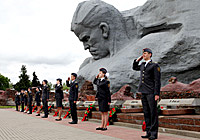 Brest Fortress is one of the most important places to see in Belarus and by far the largest tourist attraction in Brest.
Brest Fortress is one of the most important places to see in Belarus and by far the largest tourist attraction in Brest.
The fortress was not rebuilt at the end of the war, but instead became a shrine to the terrible and heroic events that took place there.
The entry of the fortress represents a huge star cut into a concrete block. The radio announcer informs about the invasion of the German army.
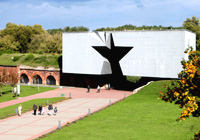 As you walk up to the centre of the fortress you see "Thirst", a large monument depicting an injured soldier trying to get some water from the river. The monument reflects the bravery of the last remaining soldiers who defended the Fortress for many days without food or water.
As you walk up to the centre of the fortress you see "Thirst", a large monument depicting an injured soldier trying to get some water from the river. The monument reflects the bravery of the last remaining soldiers who defended the Fortress for many days without food or water.
The main part of the memorial is the Square of Ceremonies, leading to the Museum of the Defence of Brest fortress and the ruins of the White Palace.
The Bayonet Obelisk, 100m high, can be seen from any part of the fortress, and is linked to the main Courage monument by 3 rows of tombstones. Only 216 of the 850 defenders who died here are known.
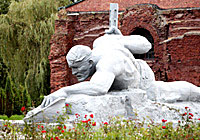 The Courage monument stands 33.5m high and tells the story of the heroic defence of the fortress through a series of carvings. There is an eternal flame which is guarded by 4 teenagers from the Pioneers Corps.
The Courage monument stands 33.5m high and tells the story of the heroic defence of the fortress through a series of carvings. There is an eternal flame which is guarded by 4 teenagers from the Pioneers Corps.
There is an Eternal Fire in front of the remnants of the former engineering department.
Further in to the Fortress you will find the iconic Kholmsky Gate, with its bullet-riddled walls.
Getting to Brest Fortress and where to stay
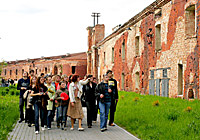 Brest Fortress is best reached on foot. It is about a 30-minute walk from the centre of Brest.
Brest Fortress is best reached on foot. It is about a 30-minute walk from the centre of Brest.
Alternatively there is an hourly bus service from the town.
Whilst you are visiting Brest Fortress you can stay in one of the many Brest hotels, which cater for a wide range of tastes and budgets.
Tourist attractions near Brest Fortress
In order to see everything that Brest Fortress has to offer, you really need to dedicate a whole day to your visit. If you stay longer in Brest there are plenty of other things to see including: 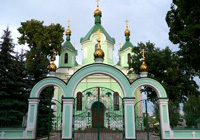
-
The Museum of the Railway Equipment in Brest
-
St Simeon Orthodox Cathedral (16th Century)
-
The museum of the Middle Age town Berestye







 print version
print version make home page
make home page add to bookmarks
add to bookmarks